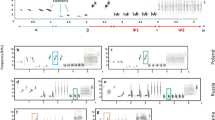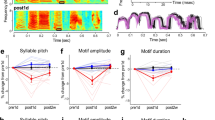Abstract
In many bird species, song changes with age. The mechanisms that account for such changes are only partially understood. Common nightingales Luscinia megarhynchos change the size and composition of their repertoire between their first and second breeding season. To inquire into mechanisms involved in such changes, we compared the singing of 1-year-old and older free-living nightingales. Older males have more song types in common than have 1-year olds. Certain song types frequently sung by older birds did not (or only rarely) occur in the repertoire of yearlings (‘mature’ song types). We conducted learning experiments with hand-reared nightingales to address reasons for the lack of mature song types. The acquisition success of mature songs was as good as that of control songs (commonly sung by both age groups). However, the analysis of song type use revealed that all yearlings sang common song types more often than mature types. This indicates that the absence of certain song types in the repertoires of free-living yearlings cannot be accounted for by learning and/or motor constraints during song learning. Moreover, our results suggest that in communication networks, animals may restrict the actual use of their signal repertoire to a certain subset depending on the context.




Similar content being viewed by others
References
Arriaga G, Jarvis ED (2013) Mouse vocal communication system: are ultrasounds learned or innate? Brain Lang 124:96–116
Arriaga G, Zhou EP, Jarvis ED (2012) Of mice, birds, and men: the mouse ultrasonic song system has some features similar to humans and song-learning birds. PLoS One 7(10):e46610. doi:10.1371/journal.pone.0046610
Baker MC, Cunningham MA (1985) The biology of bird-song dialects. Behav Brain Sci 8:85–100. doi:10.1017/S0140525X00019750
Ballentine B (2009) The ability to perform physically challenging songs predicts age and size in male swamp sparrows, Melospiza georgiana. Anim Behav 77:973–978
Baptista LF, Schuchmann KL (1990) Song learning in the Anna hummingbird. Ethology 84:15–26
Beecher MD, Brenowitz EA (2005) Functional aspects of song learning in songbirds. Trends Ecol Evol 20:143–149
Berg KS, Delgado S, Cortopassi KA, Beissinger SR, Bradbury JW (2012) Vertical transmission of learned signatures in a wild parrot. P Roy Soc B-Biol Sci 279:585–59
Bernard DJ, Eens M, Ball GF (1996) Age- and behavior-related variation in volumes of song control nuclei in male European starlings. J Neurobiol 30:329–339
Bolhuis JJ, Okanoya K, Scharff C (2010) Twitter evolution: converging mechanisms in birdsong and human speech. Nat Rev Neurosci 11:747–759
Botero CA, Rossman RJ, Caro LM, Stenzler LM, Lovette IJ, de Kort SR, Vehrencamp SL (2009) Syllable type consistency is related to age, social status and reproductive success in the tropical mockingbird. Anim Behav 77:701–706
Boughman JW (1998) Vocal learning by greater spear-nosed bats. Proc Biol Sci 265:227–233
Brainard MS, Doupe AJ (2013) Translating birdsong: songbirds as a model for basic and applied medical research. Annu Rev Neurosci 36:489–517
Brumm H (2004) The impact of environmental noise on song amplitude in a territorial bird. J Anim Ecol 73:434–440
Chaiken M, Bohner J, Marler P (1994) Repertoire turnover and the timing of song acquisition in European starlings. Behaviour 128:25–39
Cucco M, Malacarne G (2000) Delayed maturation in passerine birds: an examination of plumage effects and some indications of a related effect in song. Ethol Ecol Evol 12:291–308
De Kort SR, Eldermire ERB, Valderrama S, Botero CA, Vehrencamp SL (2009) Trill consistency is an age-related assessment signal in banded wrens. P Roy Soc B-Biol Sci 276:2315–2321
Eriksen A, Lampe HM, Slagsvold T (2009) Interspecific cross-fostering affects song acquisition but not mate choice in pied flycatchers, Ficedula hypoleuca. Anim Behav 78:857–863
Eriksen A, Slagsvold T, Lampe HM (2011) Vocal plasticity—are pied flycatchers, Ficedula hypoleuca, open-ended learners? Ethology 117:188–189
Faraway JJ (2006) Extending linear models with R: generalized linear, mixed effects and nonparametric regression models. Chapman & Hall, London, Boca Raton
Geberzahn N, Hultsch H (2003) Long-time storage of song types in birds: evidence from interactive playbacks. P Roy Soc B-Biol Sci 270:1085–1090
Glutz von Blotzheim UN, Bauer KM. (1988) Handbuch der Vögel Mitteleuropas, Bd. 11. Aula, Wiesbaden
Hammerschmidt K, Reisinger E, Westekemper K, Ehrenreich L, Strenzke N, Fischer J (2012) Mice do not require auditory input for the normal development of their ultrasonic vocalizations. BMC Neurosci 13:40. doi:10.1186/1471-2202-13-40
Hultsch H, Kopp ML (1989) Early auditory learning and song improvisation in nightingales. Anim Behav 37:510–512
Hultsch H, Todt D (1981) Repertoire sharing and song-post distance in nightingales (Luscinia megarhynchos B.). Behav Ecol Sociobiol 8:183–188
Hultsch H, Todt D (1989) Memorization and reproduction of songs in nightingales (Luscinia megarhynchos): evidence for package formation. J Comp Physiol A 165:197–203
Hultsch H, Todt D (2008) Comparative aspects of song learning. In: Zeigler HP, Marler P (eds) Neuroscience of birdsong. Cambridge University Press, Cambridge, pp 204–216
Janik VM, Slater PJB (1997) Vocal learning in mammals. Adv Study Behav 26:59–99
Jarvis ED, Ribeiro S, Vielliard J, da Silva ML, Ventura D, Mello CV (2000) Behaviorally-driven gene expression reveals hummingbird brain song nuclei. Nature 406:628–632
Kiefer S, Spiess A, Kipper S, Mundry R, Sommer C, Hultsch H, Todt D (2006) First year common nightingales (Luscinia megarhynchos) have smaller repertoire sizes than older males. Ethology 112:1217–1224
Kiefer S, Sommer C, Scharff C, Kipper S, Mundry R (2009) Tuning towards tomorrow? Common nightingales Luscinia megarhynchos change and increase their song repertoires from the first to the second breeding season. J Avian Biol 40:231–236
Kiefer S, Sommer C, Scharff C, Kipper S (2010) Singing the popular songs? Nightingales share more song types with their breeding population in their second season than in their first. Ethology 116:619–626
Kiefer S, Scharff C, Kipper S (2011) Does age matter in song bird vocal interactions? Results from interactive playback experiments. Front Zool 8:1–8
Kipper S, Kiefer S (2010) Age-related changes in bird’s singing styles: on fresh tunes and fading voices? Adv Study Behav 41:77–118
Kipper S, Mundry R, Hultsch H, Todt D (2004) Long-term persistence of song performance rules in nightingales (Luscinia megarhynchos): a longitudinal field study on repertoire size and composition. Behaviour 141:371–390
Kipper S, Mundry R, Sommer C, Hultsch H, Todt D (2006) Song repertoire size is correlated with body measures and arrival date in common nightingales, Luscinia megarhynchos. Anim Behav 71:211–217
Knörnschild M, Nagy M, Metz M, Mayer F, von Helversen O (2010) Complex vocal imitation during ontogeny in a bat. Biol Lett 6:156–159
Knörnschild M, Nagy M, Metz M, Mayer F, von Helversen O (2012) Learned vocal group signatures in the polygynous bat Saccopteryx bilineata. Anim Behav 84:761–769
Logue DM, Forstmeier W (2008) Constrained performance in a communication network: implications for the function of song type matching and for the evolution of multiple ornaments. Am Nat 172:34–41
MacDougall-Shackleton SA, Ball GF, Edmonds E, Sul R, Hahn TP (2005) Age- and sex-related variation in song-control regions in Cassin’s finches, Carpodacus cassinii. Brain Behav Evol 65:262–267
Mundry R, Sommer C (2007) Ein neues Gefiedermerkmal zur Altersbestimmung bei Nachtigallen (Luscinia megarhynchos), a new pattern of feather colouration for age determination in common nightingales. Limicola 21:131–139
Nemeth E, Kempenaers B, Matessi G, Brumm H (2012) Rock sparrow song reflects age and reproductive success. PLoS One 7:e43259. doi:10.1371/journal.pone.0043259
Nottebohm F, Nottebohm ME, Crane L (1986) Developmental and seasonal changes in canary song and their relation to changes in the anatomy of song-control nuclei. Behav Neural Biol 46:445–471
O’ Loghlen AL, Rothstein SI (2012) Delayed vocal ontogeny in songbirds: a laboratory study validates a model for delayed development derived from field studies. J Ethol 30:369–378
Osiejuk TS, Losak K, Dale S (2007) Cautious response of inexperienced birds to conventional signal of stronger threat. J Avian Biol 38:644–649
Pepperberg M (1999) The Alex Studies. Harvard University Press, Cambridge, Mass
Podos D, Lahti C, Moseley DL (2009) Vocal performance and sensorimotor learning in songbirds. Adv Study Behav 40:159–195
Poesel A, Nelson DA (2012) Delayed song maturation and territorial aggression in a song bird. Biol Lett 8:369–371
R Development Core Team (2009) R: a language and environment for statistical computing. R Foundation for Statistical Computing, Vienna, Austria. ISBN 3-900051-07-0. http://www.R-project.org
Ralls K, Fiorelli P, Gish S (1985) Vocalizations and vocal mimicry in captive harbor seals, Phoca vitulina. Canad Zool 63:1050–1056
Rohwer S (1978) Passerine subadult plumages and the deceptive acquisition of resources: test of a critical assumption. Condor 80:173–179
Sanvito S, Galimberti F, Miller EH (2007) Observational evidences of vocal learning in southern elephant seals: a longitudinal study. Ethology 113:137–146
Scharff C, Adam I (2013) Neurogenetics of birdsong. Curr Opin Neurobiol 23:29–36
Scharff C, Petri J (2011) Evo-devo, deep homology and FoxP2: implications for the evolution of speech and language. P Roy Soc B-Biol Sci 366:2124–2140
Searcy WA, Yasukawa K (1996) Song and female choice. In: Kroodsma DE, Miller EH (eds) Ecology and evolution of acoustic communication in birds. Cornell University Press, Ithacla & London, pp 454–473
Sprau P, Roth T, Amrhein V, Naguib M (2013) The predictive value of trill performance in a large repertoire songbird, the nightingale Luscinia megarhynchos. J Avian Biol 44:001–008
Svensson L (1992) Identification guide to European Passerines. British Trust for Ornithology, Thetford
Tchernichovski O, Nottebohm F, Ho CE, Bijan P, Mitra PP (2000) A procedure for an automated measurement of song similarity. Anim Behav 59:1167–1176
Todt D (1975) Social learning of vocal patterns and modes of their application in Grey Parrots (Psittacus erithacus). Z Tierpsych 39:178–188
Todt D, Geberzahn N (2003) Age-dependent effects of song exposure: song crystallization sets a boundary between fast and delayed vocal imitation. Anim Behav 65:971–979
Todt D, Hultsch H, Heike D (1979) Conditions affecting song acquisition in nightingales (Luscinia megarhynchos L.). Z Tierpsych 51:23–35
Weiss M, Kiefer S, Kipper S (2012) Buzzwords in females’ ears? The use of buzz songs in the communication of nightingales (Luscinia megarhynchos). PLoS One 7:e45057
Weiss M, Hultsch H, Adam I, Scharff C, Kipper S (2014) The use of network analysis to study complex animal communication systems: a study on nightingale song. P Roy Soc B-Biol Sci 281:20140460
Wilbrecht L, Williams H, Gangadhar N, Nottebohm F (2006) High levels of new neuron addition persist when the sensitive period for song learning is experimentally prolonged. J Neurosci 26:9135–9141
Wistel-Wozniak A, Hultsch H (1993) Konstante und altersabhängig veränderte Gesangsmerkmale bei handaufgezogenen Nachtigallen. Verh Dtsch Zool Ges 86:281
Zuur AF, Ieno EN, Walker NJ, Saveliev AA, Smith GM (2009) Mixed effects models and extensions in ecology with R. Springer, New York
Acknowledgments
The study was conducted with permission of the Senatsverwaltung für Stadtentwicklung und Umweltschutz, Berlin. Keeping of nightingales was permitted by the Landesamt für Gesundheit und Soziales, Berlin. The study would not have been possible without the invaluable contribution of Christina Sommer and Roger Mundry, who determined age and banded the birds. We would also like to thank Jan Engler, Kim Geraldine Mortega, Philipp Sprau, Christoph Teufel, Tina Teutscher and Michael Weiss for their assistance in bird netting and/or obtaining recordings, and Monica Carlson, Kim Geraldine Mortega, Heike Posern and Joana Schulz for their help in hand-rearing and tutoring the birds. We are thankful to Arpik Nshdejan for sexing the birds and Michael Weiss for statistical advice.
Author information
Authors and Affiliations
Corresponding author
Additional information
Communicated by: Sven Thatje
Rights and permissions
About this article
Cite this article
Kiefer, S., Scharff, C., Hultsch, H. et al. Learn it now, sing it later? Field and laboratory studies on song repertoire acquisition and song use in nightingales. Naturwissenschaften 101, 955–963 (2014). https://doi.org/10.1007/s00114-014-1236-5
Received:
Revised:
Accepted:
Published:
Issue Date:
DOI: https://doi.org/10.1007/s00114-014-1236-5




